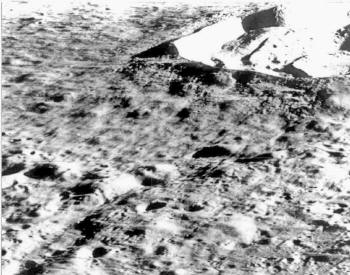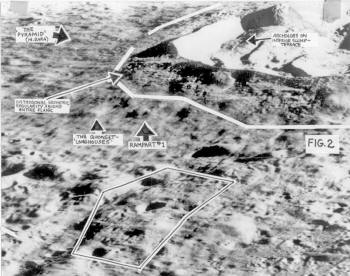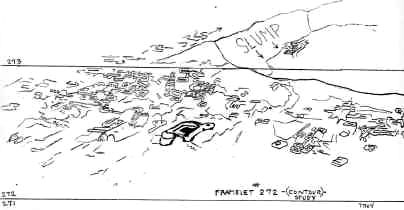|
by Steve Troy from LunarAnomalies Website
Announcement of the Big One was posted on this site last June. This is the first of four reports that will discuss anomalies discovered in the region of and including Kepler. Since 1994 when I entered into this area of research, I have yet to find a region of the moon that is more enigmatic than the area around the late epoch Copernican crater, Kepler. It has been a primary center of interest and investigation since 1995. Located in Oceanus Procellarum, this 33 km. crater was considered as secondary site #26 for Lunar Orbiter III’s camera system in 1967. In March 1965, Copernicus crater to the east, Schroters Valley around Aristarchus to the northwest, and Kepler -–were all considered possible scientific targets of no apparent use to initial Apollo flights or to Surveyors.
Kepler LOIII162M became a very popular photo that has been reproduced in lunar monographs, books and atlases. This photo was taken at a lower sun angle than many obliques taken by the first two Orbiters. Lunar Orbiter IV shot a vertical view of Kepler on frame 138. III162M was taken from a 53 km. altitude at 1.77 lat, -40.17 long. With a tilt angle at 69 degrees, the principal point of the photo is 1.63 lat. and –41.87 long. Slant distance is 131 km. and the view is looking north-northwest toward Besssarion.1 Figure #1 shows a sectional or portion of the full frame.
Fig.1. Click on thumbnail for larger version
I’ve examined most every photo in the Lunar Orbiter and
Apollo
databases that are researchable for this vicinity. On full frame
162M one sees Kepler as well as Kepler A and B
craters that lie
adjacent to Kepler to the east. Kepler A is 11 km. and B is 7 km. in
diameter. Kepler A appears fresh (LOIV138H) but is superimposed by
Kepler secondaries and lacks observable ejecta. It therefore appears
to be Eratosthenian or Upper Imbrian. Kepler B is said to be Imbrian
due to its degradation. Both including Kepler are superimposed on
Imbrium basin ejecta.2 After Procellarum flooded and after the
Kepler and Copernicus impacts, their rays and secondaries produced
NW to SE and NE to SW albedo changes in the mare. This isn’t evident
on 162M but one can see the lineaments and patterns around Kepler
that produce definitive changes in contrast.
Looking at an enlargement of the primary crater area one does see
evidence of traditional geologic interpretation. There is a hummocky
rim crest and subradial flank ridges with crushed, blocky rock,
faults, fractures and lineaments. When the 1962 LAC map of Kepler
was put together, the Lunar Orbiters had not yet flown to the moon
and therefore they couldn’t map details. Many of the more current
lunar geologic maps don’t even show what can be seen in the
grey-scales of Lunar Orbiter pictures like III162M and details as
small as the anomalies found there are too small to BE mapped very
accurately. Within the traditional structuring, there is incredible
REPETITIVE, GEOMETRIC STRUCTURE that I believe is artificial and
that has been constructed.
Fig.3 A series of 8X10 enlargement photos were developed across framelets 272 and 273 and sent to Richard Hoagland in 1995. There is a geometric structure amidst this network of angularity that has haunted me since it’s discovery. When discussing the Kepler strip of 8 X 10’s with Richard, he excitedly asked me if I’d seen what was to the left of center of Kepler just over the rim onto the flank. We discussed this astonishing structure……a Signal in the noise. There is a concentric walled fortress in this flank area that looks like a construction from surrounding surface material.
It may have looked
something like the Ziggurat at Ur, circ. 2100BC near the Persian
Gulf but is now battered and in ruin. There are right angle
concentric walls within walls and turret looking features on three
of the corners. I call it THE RAMPART. To the left of the Rampart
(west) there are two arched, quonset looking structures sitting side
by side. They are brighter than the surrounding material. These are
the "LONGHOUSES". They run into the flank of Kepler.
The Rampart
looks like a stadium and not a geologic ‘megablock’.
Click on Thumbnail for larger image
There is a transparent MINI-DOME of suspected
crystalline to the right of center frame in framelet #276. Its
remarkable defining external boundary can be seen. It is symmetrical
and transparent. To the right of this feature in the frame and
across the mare, one can detect filamentary stringers rising
vertically above the surface. Larger domes than the ‘mini-dome’ have
been discovered across and above lunar horizons.4 The high albedo
signature of some of these domes is due to light scattered off the
surface of the glass. The Crisium Dome is an example of a larger
dome. So is Richard’s Zond 3 Dome. As mentioned in my Crisium
reports, I believe the phase and sun angles must be synchronized for
the camera to be able to ‘catch’ them. They are ‘flash-units’ seen
in a moment of such synchronization. I believe they are anomalous
and are remnants of structure that once were much larger.
There is enough of it left to be able to discern basic integrity. I have found a zig-zag type of foggy haze (glass) ABOVE the horizon directly over a well known Procellarum crater that is certainly not explained within the pages of ANY scientific or lunar paper ever written! Above the upper right horizon one can see a bit of a haze reminiscent of Hoagland’s TOWER seen on III84M. There is also a peculiar looking spire just off the horizon in this area.
Fig. 5
There is a sizable slump visible within the west rim of
Kepler and
the resulting terrace can be seen in this area of III162M. It looks
to have been a clean break from the inner rim to the floor at the
fracture point. On top of the terrace there is an interesting
geometric organization. One of two things happened. Either this
visible organization collapsed intact from its original position on
the flank where it was originally with other geometric structure
(which is unlikely), or it was constructed where it is now. In a
conversation with a reputable geologist who saw this data, he made
reference to the unusual structure right at the rim above the
terrace structure and how anomalous this looked to him. Mike Bara
mentioned a step pyramid-like structure about 8 km. to the west off
the flank of Kepler. (see fig. #2) This too is unusual when seen
with a loupe in enlargements. All of this can be seen on this raw
analog photo.
|







